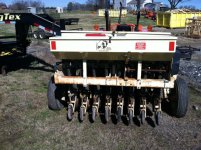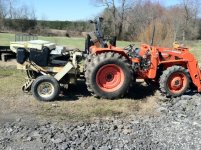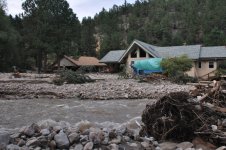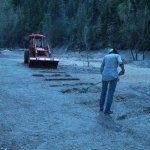rScotty
Super Member
- Joined
- Apr 21, 2001
- Messages
- 8,258
- Location
- Rural mountains - Colorado
- Tractor
- Kubota M59, JD530, JD310SG. Restoring Yanmar YM165D
I need to seed about 4 acres of hay land and don't know the first thing about seed drills or such.
Here's the situation.... we had a few acres of hay in a little field with nice dense growth (mostly bromes). It was never seeded: it just volunteered due to years of broadcasting horse manure onto that land. Nice lush growth along a creek. Then along came a flood in 2013 which stripped off all the top soil and replaced it with sand and rocks.
So for what we have now, the sand is actually the best part of it, eventually it will have some organics, but no way am I ever going to be able to get the stones & rocks out. Keeping them down below the surface is the best bet. The water table is fairly high so at least there's moisure 3 feet down. So even though it looks nothing at all like good soil, we've still got to grow something on it...just not sure quite what. The local extension agents are stumped. So we've decided to put in some 100 yd. long strips of various grasses and legumes and see what works in this new "soil".
But how to put the seed in? Will a drill work? I know nothing about them. Do they even come in small 4 to 6 foot wide style? Is there some small drill that I could pull behind the 30 hp JD?
Or alternately, there's broadcasting. Just surface broadcasting seems like a bad bet because we have a bunch of crows now (flood brought them in). And I am reluctant to broadcast and then back-drag to cover the seed because doing that pulls up so many rocks. So it would be pretty much a broadcast on the surface and mostly go to the crows
I did try some areas just hand-raking the seed in last year. That worked a bit, but for small areas only. And even so, it had poor germination probably due mostly to not having good cover over the seeds.
I'll sure rather do some sort of seed drill even if I have to do it by hand. At least doing it by hand I could avoid the rocks. Hmm.... Is there even such a thing as a hand-operated seed drill? Some sort of seed wand? It suppose if there was such a thing it would be the sort of device that an experimental farm might use.
Feel free to suggest anything.
thanks,
rScotty
Here's the situation.... we had a few acres of hay in a little field with nice dense growth (mostly bromes). It was never seeded: it just volunteered due to years of broadcasting horse manure onto that land. Nice lush growth along a creek. Then along came a flood in 2013 which stripped off all the top soil and replaced it with sand and rocks.
So for what we have now, the sand is actually the best part of it, eventually it will have some organics, but no way am I ever going to be able to get the stones & rocks out. Keeping them down below the surface is the best bet. The water table is fairly high so at least there's moisure 3 feet down. So even though it looks nothing at all like good soil, we've still got to grow something on it...just not sure quite what. The local extension agents are stumped. So we've decided to put in some 100 yd. long strips of various grasses and legumes and see what works in this new "soil".
But how to put the seed in? Will a drill work? I know nothing about them. Do they even come in small 4 to 6 foot wide style? Is there some small drill that I could pull behind the 30 hp JD?
Or alternately, there's broadcasting. Just surface broadcasting seems like a bad bet because we have a bunch of crows now (flood brought them in). And I am reluctant to broadcast and then back-drag to cover the seed because doing that pulls up so many rocks. So it would be pretty much a broadcast on the surface and mostly go to the crows
I did try some areas just hand-raking the seed in last year. That worked a bit, but for small areas only. And even so, it had poor germination probably due mostly to not having good cover over the seeds.
I'll sure rather do some sort of seed drill even if I have to do it by hand. At least doing it by hand I could avoid the rocks. Hmm.... Is there even such a thing as a hand-operated seed drill? Some sort of seed wand? It suppose if there was such a thing it would be the sort of device that an experimental farm might use.
Feel free to suggest anything.
thanks,
rScotty



